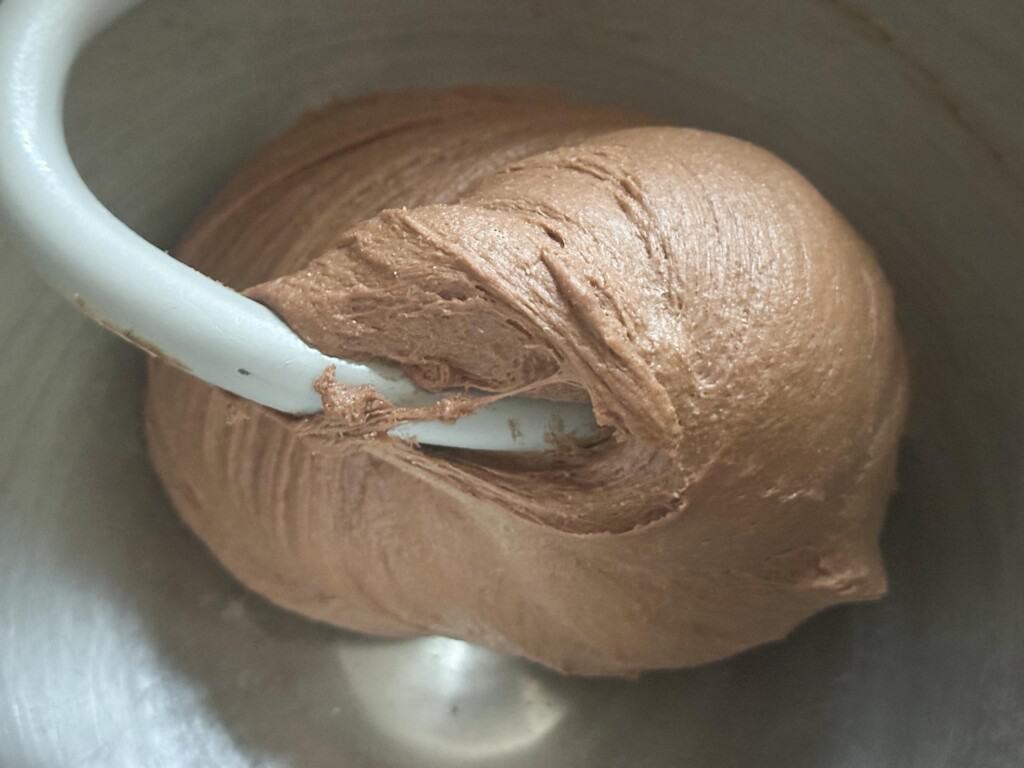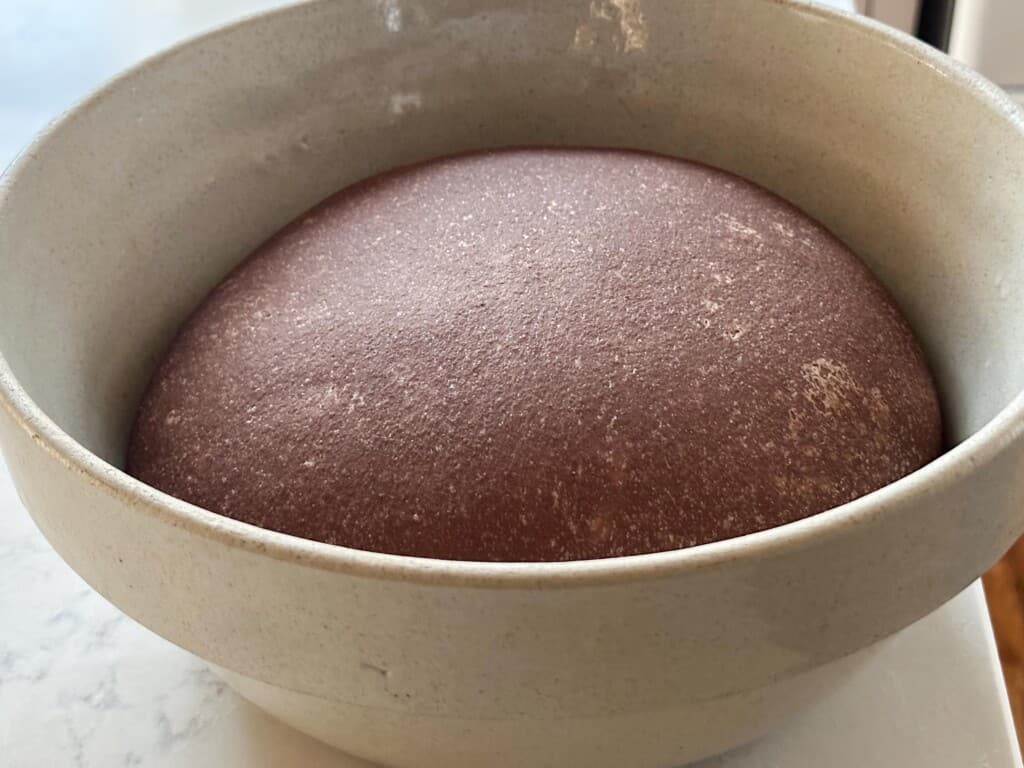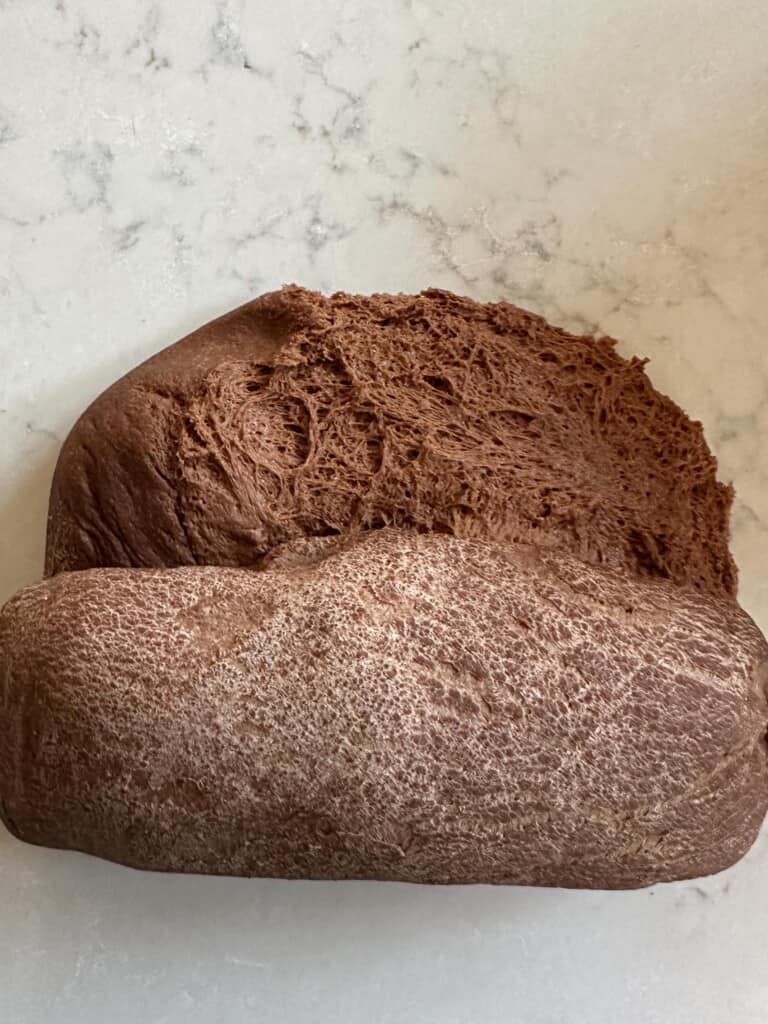This sourdough pumpernickel bread recipe is a dark, dense, and nutritious whole grain loaf that boasts wonderfully unique flavors from the combination of rye flour and sourdough fermentation.

Pumpernickel bread, which is a type of rye bread (find my sourdough rye bread recipe here), is a delicious but less common bake. Rye bread really describes any and all breads made with any form of rye flour, whereas pumpernickel bread refers to a darker, traditionally purely rye, more strongly flavored variety.
Traditional pumpernickel, being completely rye grains without additional flours, is much different than what we’re used to. It’s earthy and full of flavor, but very heavy.
For this recipe, I like to work with a blend of whole grain rye flour, all purpose flour and whole wheat flour. The result is still a denser bread, but not as heavy as pure rye. It has plenty of structure, but the crumb is tender and moist with a pleasant, chewy texture.
The color is attained through the dark rye flour, along with the addition of brown sugar, cocoa powder, and molasses. Some recipes also substitute black coffee for the water, adding further color and flavor.
This is a great bread for cold sandwiches, great for dipping in a hearty soup or even a creamy spread, and one of my favorite breads for hot sandwiches, like hot ham and cheese or corned beef and Swiss.
For being less common, it’s still quite versatile and a fun change.

Tips
- Rye flours can quickly become confusing. They can come as white, medium, and dark, with varying levels of textures and nutrition depending on what parts of the grain are left intact. Dark rye flour generally includes the greatest portion, if not all, of the grain (bran, endosperm, and germ), providing a bolder flavor and higher nutrition. This is what sets pumpernickel apart and what you’ll want to look for.
- If you have a grain mill, you can also grind whole rye berries to make your own rye flour.
- Sourdough bread made with rye flour tends to be a pretty sticky dough. This is due to rye having less gluten-forming protein than wheat flours. You won’t want to add additional flour for risk of a dry loaf of bread, but working on a well-floured surface with floured hands should help, using a bench scraper as needed.
This post contains affiliate links, which means I make a small commission at no extra cost to you. See my full disclosure here.
Tools You May Need
Bench scraper
Food scale or measuring cups and spoons
Loaf pan or Dutch oven
Grain mill

Ingredients
Sourdough starter – Fed, active and bubbly.
All-purpose flour – Use what you like! I go for unbleached.
Dark rye flour – Dark rye flour or pumpernickel flour, either would work, and each offer the substance and flavor we’re after.
Whole wheat flour – Fresh-milled hard white wheat is my favorite. Store-bought will also work.
Brown sugar
Molasses – For the rich flavor and lovely, dark hue.
Cocoa powder – Adds further complexity to the overall flavor, while also adding to the deep color.
Butter – Softened so it will mix well.
Salt
Water – Filtered water is best for avoiding chlorine and other chemicals and properties that may alter fermentation and rise.

How To Make Sourdough Pumpernickel Bread
Like all fermented sourdough recipes, this one begins with feeding your starter. Give it time to become active, somewhere in the range of 4-12 hours before beginning the recipe.
If you’re familiar with keeping a starter, you’ll have noticed by know about how long it takes for your starter’s activity to be at its peak. As always, it’ll have grown significantly and will be producing lots of bubbles.
You can learn how to make your own homemade sourdough starter here.
Kneading The Dough

Add your active starter, flours, sugar, molasses, cocoa powder, softened butter, salt and water to the bowl of a stand mixer with a dough hook.

Mix at low speed for 2-3 minutes until you notice the dough pulling away from the sides of the bowl into a ball. Bump up your speed and mix for another 4-5 minutes. With the Kitchen Aid, you do not want to go over speed 2 when mixing bread doughs.
Check for proper gluten development by using the windowpane test. Take a small piece of dough and pull it apart in a rectangular shape, checking if the center is stretching to a thin, see-through “windowpane” where light can be be seen through it, or if it simply tears or breaks apart.
Tearing too easily indicates the gluten needs more time to develop. If this is the case, continue mixing another few minutes.
Bulk Fermentation

Set the dough in a lightly oiled bowl covered with a damp tea towel, plastic wrap or a lid. A dry towel will cause the dough to dry out considerably, and we want it to stay moist.

Place in a warm location to begin the bulk fermentation. We’re looking for doubling, and this should be somewhere in the realm of 8-12 hours.
The length of the bulk fermentation will vary based on the season and temperature of your home. During the summer, this first rise may take quite a short time, while a rise time in the winter could be much longer. My pantry stays fairly cool during the winter months, and this lower temperature allows my rises 12 or more hours of fermentation before they are ready.
Shape And Second Rise

After the first rise, roll out the dough (or just pat out with your fingers) into a rectangle on a floured surface. Shape by rolling up as a traditional loaf and pressing down the seam.

Place seam-side down in a lightly buttered or parchment paper lined loaf pan. You can use a Dutch oven in place of a loaf pan, working your dough into a boule or round loaf.

Again, cover your pan with a damp tea towel and let the dough rise in a warm place for 2 to 4 hours until doubled.
With the completion of your second rise, preheat the oven to 375.
Score the top of your loaf, if desired. This creates a beautiful crust with very little effort.
You can add an optional egg wash at this point. Whisk together one egg with a tablespoon of water, then brush it over the top of the loaf.

Bake for 35 to 40 minutes, cooling completely before slicing.
Storage
As with most breads, store in an airtight container or bag once cooled to room temperature. On the countertop, it will stay fresh for several days.
Stored in the freezer, you can keep for several months. Simply thaw to room temperature before use. Find out how to freeze sourdough bread here.
FAQ
This bread is known for its intense flavor, which works rather harmoniously with a variety of toppings, including cream cheese and cucumber, smoked salmon, freshly sliced meats and cheeses, chicken or tuna salad (or even egg salad), corned beef, or simply a thick slab of butter.
Pumpernickel is a traditional European bread, particularly tied to Germany. It was considered a peasant bread for most of its history, and more recently began resurfacing in upscale bakeries and markets as a popular choice.
In the United States, pumpernickel is generally made using a blend of flours, white and wheat alongside rye, but it was originally made with only rye flour, producing a more dense, fiber packed loaf known for its strong flavor and dark color.
Historically, pumpernickel bread was a very long bake – baking all day long at a low temperature, which coupled with the dark rye flour, gave it a deep brown hue.
American pumpernickel bread is quite a bit different, baked for a much shorter time, incorporating a blend of flours with the rye to lighten the texture, and will usually include molasses, brown sugar, and cocoa powder to achieve the color characteristic of pumpernickel.
Many of the pumpernickel options you find in stores have artificial colors added.
Try one of these great recipes to pair with this bread:
- Roasted Red Pepper and Tomato Soup
- Easy Zuppa Toscana Soup
- Sourdough Grilled Cheese
- Sourdough Breakfast Strata
- The Best Shepherd’s Pie
If you try this recipe and love it, I would love it if you gave it 5 stars! Thank you! Tag me on Instagram @farmhouseonboone.
Sourdough Pumpernickel Bread

Ingredients
- 1/2 cup sourdough starter: bubbly and active, 113 g
- 1 1/4 cup all purpose flour, 175 g
- 1 cup dark rye flour, 135 g
- 1/2 cup whole wheat flour, 75g
- 1 tablespoon brown sugar, 13 g
- 1/4 cup molasses, 70 g
- 1/4 cup cocoa powder, 30 g
- 1/4 cup butter, softened (56 g)
- 1/2 tablespoon salt, 8 g
- 1 cup water, 236 g
Instructions
- Feed your sourdough starter 4-12 hours before beginning the recipe. It should be really nice and bubbly.
- Add your active starter, flours, sugar, molasses, cocoa powder, softened butter, salt and water to the bowl of a stand mixer with a dough hook.
- Mix at low speed for 2-3 minutes until you notice the dough pulling away from the sides of the bowl into a ball. Bump up your speed and mix for another 4-5 minutes until the windowpane test is met*.
- Set the dough in a lightly oiled bowl covered with a damp tea towel, plastic wrap or a lid. A dry towel will cause the dough to dry out considerably, and we want it to stay moist.
- Place in a warm location to begin the bulk fermentation. We're looking for doubling, and this should be somewhere in the realm of 8-12 hours.
- After the first rise, roll out the dough into a rectangle on a floured surface. Shape by rolling up as a traditional loaf and pressing down the seam.
- Place seam-side down in a lightly buttered or parchment paper lined loaf pan. You can use a Dutch oven in place of a loaf pan, working your dough into a boule or round loaf.
- Again, cover your pan with a damp tea towel and let the dough rise in a warm place for 2 to 4 hours until doubled.
- With the completion of your second rise, preheat the oven to 375.
- Score the top of your loaf, if desired. This creates a beautiful crust with very little effort.
- You can add an optional egg wash at this point. Whisk together one egg with a tablespoon of water, then brush it over the top of the loaf.
- Bake for 35 to 40 minutes, cooling completely before slicing.
Notes
- *Check for proper gluten development by using the windowpane test. Take a small piece of dough and pull it apart in a rectangular shape, checking if the center is stretching to a thin, see-through "windowpane" where light can be be seen through it, or if it simply tears or breaks apart. Tearing too easily indicates the gluten needs more time to develop. If this is the case, continue mixing another few minutes.
- Rye flours can quickly become confusing. They can come as white, medium, and dark, with varying levels of textures and nutrition depending on what parts of the grain are left intact. Dark rye flour generally includes the greatest portion, if not all, of the grain (bran, endosperm, and germ), providing a bolder flavor and higher nutrition. This is what sets pumpernickel apart and what you'll want to look for.
- If you have a grain mill, you can also grind whole rye berries to make your own rye flour.
- Sourdough bread made with rye flour tends to be a pretty sticky dough. This is due to rye having less gluten-forming protein than wheat flours. You won't want to add additional flour for risk of a dry loaf of bread, but working on a well-floured surface with floured hands should help, using a bench scraper as needed.
Nutrition
Nutrition information is automatically calculated, so should only be used as an approximation.










For the nutrition, what is the amount in g or oz?
Thank you!
How can this be made without a stand mixer?
Lisa, thank you for sharing your pumpernickel sourdough recipe. I ran into a couple of issues even though I followed the recipe exactly. After mixing, the dough didn’t pull away from the sides of the bowl. It was clearly too sticky even after additional mixing. I added alittle extra flour hoping it would help, but not much. I continued with the next step (bulk fermentation) and got a good rise. However, when I rolled out the dough it was still too sticky to work with so I added some cocoa powder and more flour so I could work with it. The final product was a nice loaf, however, it seems to taste pretty strong (I think too much additional cocoa powder). Please advise, as I’d like to continue to use this recipe
Is there a reason that you used all-purpose flour instead of bread flour? Will the bread flour give better gluten formation? Thank you 🙂
You can use either! With a strong starter, you won’t notice a difference.
This made a really good loaf. It is a bit more chocolate forward than I’d like, perhaps because I used cacao powder instead of cocoa powder? For the next loaf I’m going to try reducing the cacao and adding some red rye malt. I estimated the volume of your pan at 1.2 liters and scaled the recipe down but it came out taller than I expected. The loaf has a really nice texture.
This is a keeper that I will tweak a bit.
Glad you still enjoyed it. Let me know how your tweaks go.
Perfect in a Pullman. I was making breads for tea sandwiches for my niece’s bridal shower and needed a pumpernickel bread.. This bread was delicious and perfect. I am making another loaf today for myself! I am also glad there is no cornmeal in this recipe since many pumpernickel breads do have it. I am allergic.
Just scrolling thru and found this beautiful recipe. It’s fresh off the press and getting stirred up this afternoon. Beautiful recipe – thanks so much for sharing!!
I have just ventured into the world of sourdough and I love it. Thanks so much for your posts, they have helped me a lot! This is going to be my next loaf, can you please tell me what size your loaf pan is? I have various sizes and don’t want to use one that is too small or too big. Thank you.
Here’s the loaf pans I use.
Hi Lisa, Is there anything I can substitute for the cocoa powder? I am allergice to chocolate. (so sad!) Thank you.
The cocoa powder is to help color the bread. You could try using caramel color powder instead.
Try carob flour 🙂
Can we top with sesame seeds? How would you recommend doing so?
Yes. I would just sprinkle on top before baking!